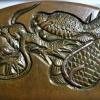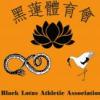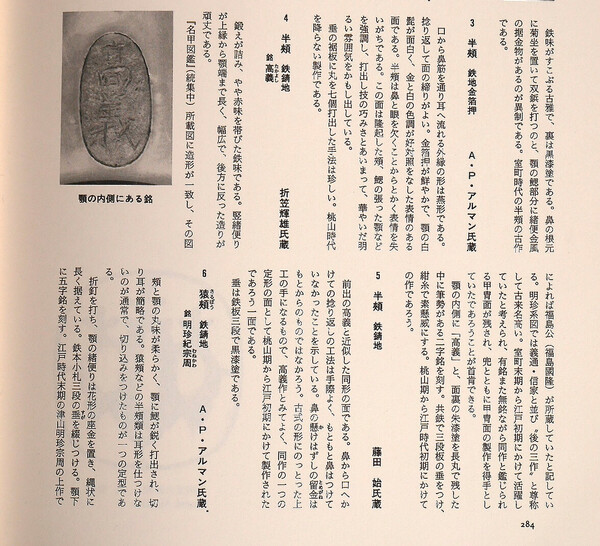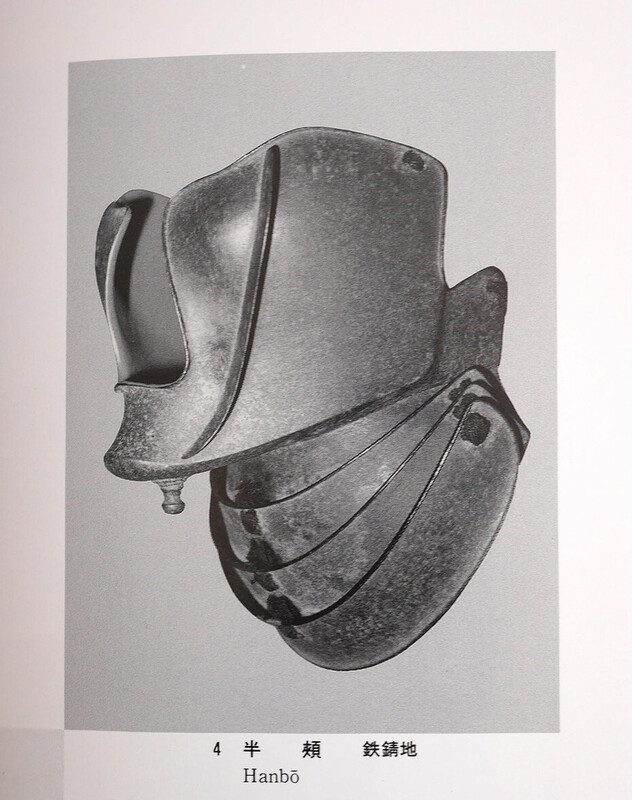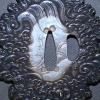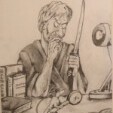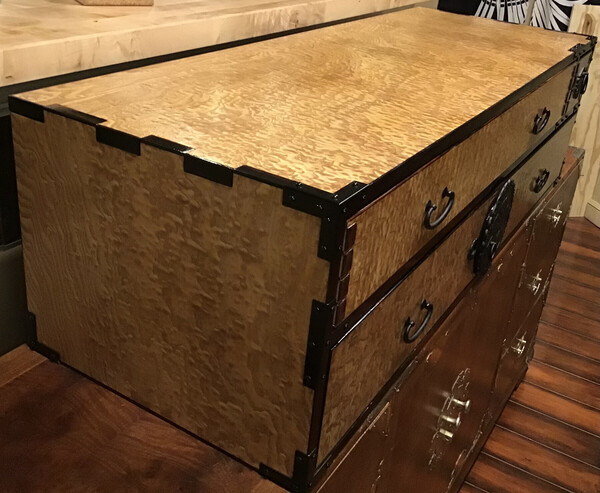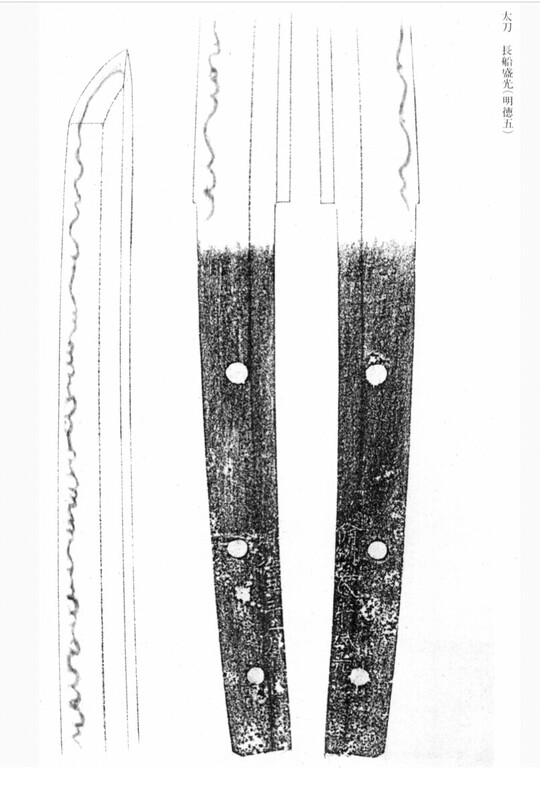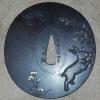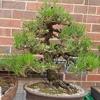Leaderboard
Popular Content
Showing content with the highest reputation on 06/25/2021 in all areas
-
I just got this tsuba from Italy. I always wanted a good rendition of millet, a theme I appreciate. The really good stuff is stratospheric. This was reasonable. Sold as Fujiwara Mitsunobu. It reads, I believe Iyo kuni Matsuyama ju Fujiwara Mitsunobu. A Shoami school artist. Correct me if I'm wrong. John2 points
-
I would like to share with you on some samurai objects, for several years I have been collecting mainly elements and armor from the Momoyama Muromachi period or earlier (when it is possible to find it of course), the Edo period produced superb armor real objects of art but it is the historical and warlike aspect that fascinates me. I am obviously interested in your comments, clarifications or possible corrections on my descriptions. The first object is a Muromachi hoate which is quite simple in design but very natural in shape: Hanbô-shaped natural iron half-mask, covering half of the face and excluding the nose. The gorget (yodarekake), from edo period, consists of 4 lacquered metal blades joined by dark blue silk cords. Half masks from the Edo period only offer defense on the side of the cheek, this one is designed to cover even near the nose in front of the face. Half-masks from such an era are rare pieces. The narrow size of the nose opening immediately suggests a very old date, also confirmed by iron corrosion, which allows the object to be dated to the 16th century end of the Muromachi period (1336-1573). What appears to be a kirikomi (combat mark) is present on the back left side of the mask The general shape of the mask is very similar to a model drawn in the Meiko-zukan-zokushu signed by Yoshimichi and the hanbo by Takayoshi in the Orikasa collection. The curved lip and well-balanced lines follow the same design , as well as the sweat drainage tube (ase nagashi), here we find an otayori to fix the helmet lacing and wick away the sweat.2 points
-
So! You are browsing tsuba and one catches your eye, it's got a bit of a Higo vibe. It's not much money and you are thinking of taking a shot but something about the seppa dai seems off so you can it. It pops back up at half the money and on a bit of reflection you reckon the seppa dai has seen some use but for what it costs it's worth it for a look see. You place a minimum bid, sit back and wait. Lo and behold you win. The package arrives and as you take it from the postie you can hear the tsuba rattling around inside it's box. You open the package and see that it is in a deluxe tsuba box so that's a win whatever happens to the tsuba. But the sender has sealed the box with duct tape. You manage to get the duct tape off without damaging the box And the tsuba is genuine, what's more it is better in hand than the photos. I'm sure we all know the feeling but thought you might enjoy this one. All the best.2 points
-
2 points
-
If you want to sell it here you will need more photos, with more detail, including of the nakago.2 points
-
Hello, Its a pleasure Thomas and still looking out Trystan....Bruce , all of the fittings have matching numbers including the locking catch....I only just noticed the nakago has two letters stamped on it as well as being numbered...The saya does not have any numbers or letters on it.. Regards, Paul..2 points
-
Dear All, with no further suggestions since Monday I believe this has run it's course. answer and explanation listed below: The blade has been attributed to the Shikkake School of the late Kamakura/early Nambokucho period. It was awarded a Juyo attribution in the 46th session. Congratulations to those who took part and got the correct answer. I think it is reasonable to say that Naginata Naoshi are not normally found with Juyo certification. In line with the NBTHK definitions the blade has to be of high quality workmanship and in line with the characteristics of the school. So why was this mumei, much altered, blade awarded this level of certificate? I hope the following may offer some explanation Shape: Allowing that the shape of the blade has been changed the naginata retains the elegant, almost gentle sugata associated with blades produced in the Kamakura period. As the Nambokucho progressed swords generally became more robust and larger. In the case of Naginata they became longer, broader and the curve at the kissaki deepened. They just got a lot bigger! So the shape points towards the Kamakura period. Hada and Hamon: As said above the workmanship is clearly visible and of very high quality. When compared to the descriptions of what one should expect of the Shikkake School this sword exhibits every listed feature and they are all clearly visible in hada, hamon and boshi. Having established it to be the work of the Shikkake School, further examination pin-points it more precisely. Established references confirm that the quality of later Shikkake work falls off. This manifests itself as a reduction in activity in the hamon, much less Ji-nie and more open hada. Taking these points into account this sword can only be the work of the earlier Shikkake School, thus supporting the opinion already expressed based on the shape of the sword. The Yamato tradition offers a lot of challenges in kantei, not least that so few of their blades were signed. I think they also have a reputation for being utilitarian and lacking the artistry of other schools. I think this is unfair especially when looking at the early works of the Tiama school, Tegai Kanenaga and Shikkake Norinaga. The problem I think is that as with so many schools quality reduced as time progressed and most blades we see, which tend to be late Tegai work, do not reflect the quality of earlier pieces. Also the differences in the schools can be very subtle. We have all seen examples of blades being papered to one school and then on resubmission to another. One needs to look at the fine detail and try and come to a judgement which is what I believe the Shinsa panel did with this work. It had all the features they expected to see in a Shikkake blade and the level of quality to place it at the earlier period of the school’s production.2 points
-
1 point
-
Bruce - The kokuin is a combination of the characters Hi (nichi) and Ten (Ama) Masahiide is the first to use it - he had as many as five different stamps with the same kanji over the course of his career. There were three generations of Masahide and they all used the stamp to my knowledge. Later in his career he styled himself Amahide using various combinations of kanji. Amahide (Showa) was a student of a student of, so was in the Masahide line and therefore used this same stamp on his swords. The particular form of Masa seen in your example is a short-hand version of the Sei (Sho) kanji... -t1 point
-
1 point
-
This is certainly an interesting piece, and to my eyes, it has a HIZEN touch (or 'influence' as some say ). I am sure that the right craftsman can make the repair invisible.1 point
-
1 point
-
1 point
-
1 point
-
Hi Simon, difficult to tell from the images, but is that koshirae modern ?1 point
-
Meirin Sangyo - One of the oldest suppliers of budogu in Japan - very reputable - very reasonable prices especially in their "reasonable Price" section as you might imagine. Tomano Sensei is head of the local (Osaka) branch of the NTHK... -t1 point
-
Sorry - had to wait to get home and look at this on the tablet - I agree with Barry the tip is the most significant damage, that we can see. the question of restoration I think should go to a polisher - regardless of the validity of the mei - it would obviously be a labour of love since reshaping the kissaki would alter the original shape... -t1 point
-
Difference in seppa dai I think just proves it's a late piece. Regarding the ana, they have a Higo feel to them, that Higo influence can also be seen on the missing zogan, it's common for them to have a fabricated 'worn' look. I do stress 'influence' however, this isn't a Higo tsuba.1 point
-
Dear Piers. Thank you for your thoughts. I had assumed it to be a wheel of the law design, in fact most of the zogan on the blades is present, not showing very well because it is in silver and tarnished. It is in net form, that is discrete lines of silver crossing each other. The difference in the seppa dai was one of the issues that made me pass it up on first inspection, I can't remember coming across this before. Any ideas? All the best.1 point
-
1 point
-
Paul, once again, many thanks for the additional pictures. The subassembly method of your sword is similar to another Shinbu-Tō that is linked to below. One obvious difference that I can see is that the reverse tang on yours is marked 振武 while the other sword is marked 振武刀. Unfortunately, the nakago mune markings on this second sword do not appear to be noted or pictured. It is thus not possible to determine which marking precedes the other at this time. For your information and that of others, this is the same sword that is illustrated over at Ohmura's website. Hefty WW II Era Katana with High End Mounts Nakago Reverse: 振武刀 = shinbu-tō Nakago Obverse: 東洋刃物株式会社作 = Tōyō Hamono Kabushiki Kaisha saku = Made by Tōyō Knife Company., Limited. As an aside, 振武 is spelled as shinbu but should be pronounced as shimbu. N (kana)1 point
-
I hope you've invested in a few books to study. Fellow NMB member Markus Sesko has written quite a few. Welcome aboard.1 point
-
George, I think not. At least the rule should be that the nengo is symmetric - if the mei is in the nakago shinogiji, that is where the nengo would be on the opposite side. Also the positioning on the nakago would be the same (here the mei is towards the nakagojiri due to suriage). I think what you are [trying] / [hoping] to see appears to be towards the hassaki side. Is it also higher up? I cannot tell. Honestly, try with some of the meikan and show it to someone in hand in the US. We are focusing a lot on the mei but there is enough of the hamon and hada to study. Compare to some of the Oei guys (the problematic issue you have is the unusual mei / syntax for that time). For earlier smiths, I would expect a much more “active” hamon (see separate topic on the active hamon :)). So, some headscratchers which need to be resolved with spending the time with the blade, Osafune taikan, Sesko books plus online images of relevant smiths. Invest the time, learn, enjoy….1 point
-
Fair point and very good observation, Christian! There is indeed such filing on the opposite side (ura) of the mei side (omote) but that affects mostly the bottom part of the nakago and is particularly accute in cases of osuriage. When we have minimal shortening by clipping the jiri, not really. See attached clearly shortened blade with retained nagamei and nengo. Most of the examples I attached are not such extreme cases of shortening as to cause nengo removal.1 point
-
Strike one broken tip Strike two cup in the ha Strike three delamination shown in the last photo If it was mine, I would not have it restored.1 point
-
1 point
-
Dear Charles. Yeah! It's great when you need it but evil when you don't. Sounds like you have an interesting job. I am fairly convinced that this one had a hole cut in the seppa dai to accommodate the catch on a gunto mount. Someone has patched it subsequently, not sure they did it any favours.1 point
-
Wow. That is really nice. My wife doesn’t want me to build one. She says that if I build one with extra spaces that I will just want to fill them up and I already have my next two swords undergoing shinsa in Japan.1 point
-
Good visual glossary: http://japaneseswordindex.com/glossary.htm and http://japaneseswordindex.com/military.htm and many more pages at the homepage.1 point
-
You can also look at usagiyas very informative Website http://www.ksky.ne.jp/~sumie99/information.html http://www.ksky.ne.jp/~sumie99/terms.html1 point
-
Adam, this one seems to be a handmade one. Your question 'Should I stop buying?' can only be answered by you. If you have lots of money, you could buy loads of TSUBA and post them here, so with the comments there might be some learning as a result. Buying books and looking at many (high quality) TSUBA from other collections might be another option. In your case you could try to get into contact with other collectors and let them guide you a bit. Don't look at the age of an item. This is not as relevant as quality.1 point
-
Ah… so this is a cast one too… was thinking possibly carved plus the fact it had been on a few blades… oh well…thank you so much for the input… so true spend more get more. lucky I still like it…. Is the signature just rubbish too? when would this have been made. if they say period tsuba what date that referring to?1 point
-
I found The Connoisseur's Book of Japanese Swords by Kokan Nagayama to be a really useful addition to my library.1 point
-
Hi Brian, There are gobs of sword terms in Japanese; witness this book: https://www.japaneseswordbooksandtsuba.com/store/books/b103-1100-Japanese-sword-terms-and-400-named-blades but you don't need to know any where near that many to get started. Yumoto's The Samurai Sword: https://www.japaneseswordbooksandtsuba.com/store/books/b771-samurai-sword-handbook-yumoto or Sato's The Japanese Sword: https://www.japaneseswordbooksandtsuba.com/store/books/b138-Japanese-sword-kanzan-sato will cover the basics and that's enough to begin. Keep reading, studying, & looking at good swords; you'll be pleased with your progress. Grey1 point
-
Where do we start to camp out for the $60k Masamune? Can the line start after me? This line about there being $60k Hozon, Tokubetsu Hozon Masamune that will lose their status, I think is begging to see some tangible examples. As for handling many of them, I don't know where you are going that you can poke around in a drawer full of inappropriately papered Tokubetsu Hozon Masamune. Here is why you cannot price such a thing at $60k: 1. if it has so many issues and is so full of doubt, it is not worth $60k and nobody is likely to buy it 2. if it is not with that doubt, it will not be priced at $60k or if it were, that would last for a few picoseconds until someone picks it up and resells it at a price the market supports Consider a simple gold coin. If it is a real one ounce gold coin and you put it on ebay at $200 it will be gone in that same picosecond, to be sold for the price that gold fetches in the market every day and the lucky person will have themselves a profit. If it looks like it is made of copper rather than gold (i.e. so full of doubt) then nobody will pay $200 for it. We see this of course every day with the green papered Masamune that are constantly on Yahoo auctions. The sellers are not stupid, so they float them at zero so the speculators will bid to whatever the price of speculation will drive them. Or, they will price them at the price the market will pay for a Masamune. To price them at 20% of the price of a real Masamune is literally "neither here nor there." It is low enough to cause suspicion and it is high enough to cause suspicion. It is so low that the speculators will take pause. It is so high that the speculators will take pause. It is so low that the legitimate collectors will take pause. It is so high that the legitimate collectors will take pause. The market is not necessarily rational but it sure is very efficient. If you are encountering "many" of these by your own words, and were not impressed, you are implying that the NBTHK is cranking out Tokubetsu Hozon Masamune with great frequency. It's like saying you went into someone's house and saw "many" cockroaches. If you saw one only, it implies the existence of a good number you can't see. If you saw a good number, then there are many. If you saw many then there are a very large number. If there is a very large number, or even if there are many, then others of us will also be encountering them in person or online. Japanese well understand that green papers are garbage and yet there is still some kind of a speculation market on Yahoo auctions for green papered "Masamune". A modern Tokubetsu Hozon Masamune one can buy for $60k regardless of the impression level a foreigner may have for the blade, will not matter because of market efficiency. These items will be snatched up and find their way to major auctioneers or to Yahoo auctions at the bare minimum. If nobody has seen any except for one person who claims to have seen many, then there is some difficulty in explaining this phenomenon if we are to take it at face value. Because honestly there are enough low end dealers that would be able to lay their hands on those and turn them over for big prices on Yahoo auctions that they would simply appear there. Yet they don't. The idea that rather instead they are laying around in drawers inactive in the market, at low prices that would be blown through on an auction site, is far fetched. Everyone would speculate on such pieces and believe them to be easy Juyo. We have seen already on Sotheby's a Tokubetsu Hozon Norishige fetch more than this likely with this kind of speculation. Should such a "Masamune-prime" exist, it would have as well to have so many attestations and historical reasons to be a Masamune that it could go to Tokubetsu Hozon and yet, be so, so very wrong that it cannot approach the standards for Juyo, that again, it would be something that would fail to have any value. As you increase the level of the smith involved you increase the stakes dramatically. The higher you stake that claim on day one, the less room you give yourself to maneuver later. If the NBTHK were in the habit of tossing around Hozon for fake Masamune like used kleenex, the damage it causes to the organization as a whole is substantial. You are entering fraud lawsuit areas that you don't enter when you mix up Bungo Bingo Bongo. There is no point to stick your neck out at Hozon and Tokubetsu Hozon for Masamune when there is a great chance you will get your head cut off at Juyo. This is instead where you stick your neck out as den Yukimitsu and then give yourself another chance to reconsider at Juyo with more people and more attention. There are so very few reasons to paper something to Tokubetsu Hozon as Masamune that cannot go higher, you can count them on one hand. Those are that the condition is so very poor there is no chance, but the blade is legitimate. In which case, someone with knowledge should still find areas in it to be impressed, but to simply feel sad that the blade is worn away; or that the blade is retempered, and in which case the blade is going to have to have status as a famous old piece or else it will lack the exact dimension necessary in which to pass as Masamune (the best quality nie); or that the attribution is so very, very unreliable that the work cannot even classify as one of the better Soshu smiths for which there may be major to minor overlap with Masamune (in which case it does not have the standing to get to Hozon as Masamune, but it will simply be denied if under kinzogan or papered to whatever it is thought to be regardless of stacks of old paper). There is only a major disaster for all parties involved in generating drawers full of Tokubetsu Hozon Masamune that cannot impress a foreigner and do not have the capability to pass Juyo. Furthermore, there just lacks a reason for this to happen other than offering up that the people doing building such a situation are completely without credibility. I point you to an alternative to explain the phenomenon you have noted, if indeed it is real as nobody else has testified to it. That is in this same thread you have maligned the reputation of Honami Kochu and held his papers to be without merit, failing to impress you and so easily faked that they are indistinguishable from the real thing. A drawer full of $60k Tokubetsu Hozon Masamune that are not impressive in the least has such a simple easy explanation attached to it and Occam's razor applies. I've written elsewhere the slow pace at which consideration for Masamune is given. I have not, myself, encountered these large quantities of inexpensive and unimpressive yet faithfully papered Masamune in all of my experience in Japan nor has anyone offered up any links to them in Yahoo auctions in the last 25 years that I recall. I am aware of very, very tired Masamune that are correctly executed and still pass Juyo. There are those that pass Juyo with notes in the setsumei about how the attribution has doubts and even with that the market price on such things are quite high. It is very easy to write "to kinzogan mei ga aru" on papers, or to do den Yukimitsu at Tokubetsu Hozon so you can change that to Masamune and explain in detail at Juyo because it is still, outside of the Masamune attribution, a sword with Juyo features that can stand as such on its own. And if it doesn't, then no reason to do this outside of not knowing your material. I have had in my hands famous pieces from the Kyoho Meibutsucho, and Juyo and Tokuju, Juyo Bunkazai Masamune, and those with no papers and no reputation but still exhibiting enough attributes that I would say Masamune and try to pay a lot for them. I have been able to buy three legitimate ones in my life and I had opportunities to buy unpapered ones at high prices... in such cases I turned one down out of being gutless and saw it after this go all the way to Tokubetsu Juyo. I wish to say I could have handled a Kokuho one, but I have not, I have only had one Kokuho in my hands and it was not a Masamune. But many times with Juyo Bunkazai up to Sadamune and Masamune and so forth from daimyo families and Hideyoshi's personal item that went to Ieyasu and various shoguns beloved pieces. But, I have not encountered a drawer full of Tokubetsu Hozon Masamune that failed to impress me to date. If they are legitimately papered, the line starts after me please at $60k and I will take my chances with any particular foreigner not being impressed. Lastly the proof of NBTHK papers it to look up the serial numbers. Also, the proof of an old Honami Kochu paper can often be verified by looking at the records of collections from whence it came. The best proof though is the eyeball test. Knowing what you are looking at substantiates the paper more than the paper should be used to substantiate the thing you are looking at. If you are routinely looking at junk swords of the highest attribution possible without the capability of passing Juyo you are probably in some kind of strange, uncharted waters that are dangerous to be in.1 point
-
Darkon, John, all good questions. An appraisal book just wouldn't work however. For example, I have 2 EMURA'S both signed the same, both in good outfits. Put the 2 together and you could get USD3500 for one, and USD2500 for the other. They are chalk and cheese in regard to workmanship, every sword is different, and appeals to collectors in different ways. In regard to "gendai-to nonsense" as you call it, the WW2 stuff even if "beat up" appeals to both nihonto and militaria collectors. There is a certain "aura" a WW2 gendai-to has, in so much it was made was a weapon, like the Samurai swords of old, and not a piece of art for arts sake. The price is what people are prepared to pay at a particular time.1 point
-
When I first started collecting (mainly gendai), I would buy at dealer prices. For the past few years, my thought strategy is to pay only what I could recover if I sold it. And if I buy a sword out of polish, I factor in the cost to polish. I have sold quite a few swords on NMB in the past year, and all get snapped up within a day. The reason, realistic prices, I always leave "a bit in it for the next owner". Only an observation, but many shinsakuto swords that have been listed on the NMB, never resell for the price the owner paid, and you see reduction after another, or withdraw from sale. Unless you buy really well, swords are not a good investment, you buy what gives you pleasure, enjoy it, and sell it for the current market price.1 point
-
Nihonto should never be seen as an investment. Besides the very high end, enjoy being a caretaker and love learning.1 point
-
My dai hard belief - once you don't actively collect, sell everything above what you really like to have. Zero evidence nihonto ever managed to beat stock market. At any level. All discussions about it being good investment long term are dealer speak.1 point
-
I saw this sword on the Showa22 web site and if you look carefully, you can see the handle has been re-wrapped recently and not by someone familiar with how the Japanese would do it.1 point
-
Russ, To some extent you’re buying the signature. However much you like the pictures of the blade, you need to be confident that the signature isn’t forged. Without papers or a lot more knowledge you can’t be. You’re new to this and taking a pace back and seeing what else is out there and just doing some learning won’t kill you. There are lots of swords for sale, often with authentication papers, so chill for a bit and look at what more reputable dealers have for sale. Most of us have been where you are and have bought without sufficient forethought and regretted it.1 point
-
1 point
-
Separate from the seller, Kanekura is a rarely seen smith. I sold a katakiriba tanto by Kanekura at one point and there is a sword of his in the Compton collection catalog.1 point
-
The condition of the sword is very good. Nice leather sheet and mountings. Blade looks good for me. The only problem with showa22 is that all of his swords get that terrible polish which look like brighten with acid.1 point
-
Showa22 perpetuates the myth of the pilot/tank crew sword. These shorter swords are wakizashi's pressed into service during the time when the longer regular swords were in short supply. They are normally older blades, sold or donated, that have a leather combat cover placed over the wood saya. Some of these wakizashi's can be quite good old blades. If the pilot sword was a fact, then they would have been manufactured during the war for air crew. In fact waks made in WW2 are VERY RARE. These shorter swords were normally sold to officers with non-combat desk jobs, so length didn't matter. This is another reason that they are found in good condition, they were never used in combat.1 point
-
I would respectfully disagree. After you have sold enough blades, then you know what flaws are, how to photograph and explain them, and you know shite polish. Agree not as much of a scammer as Samurai Monkey, but he is disingenuous. Maybe thats a better term than "scammer"1 point
-
1 point
-
1 point
-
1 point
-
1 point
This leaderboard is set to Johannesburg/GMT+02:00


